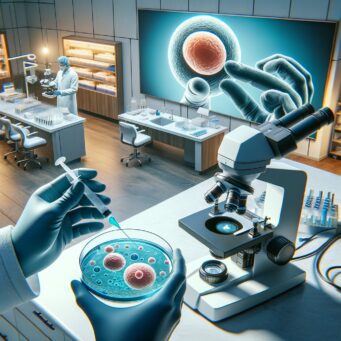
Presented by TMRW Life Sciences
Imagine it’s the year 2100. Hundreds of millions of people were born thanks to the help of cutting-edge cryopreservation technology, according to RBMO Journal. Due to medical advances in the field, almost all of these births were associated with embryos and eggs that were once frozen and stored in a lab.
This is the future of fertility. Anyone can embrace the option to build a family. How did we get here?
IVF: Then and Now
Today, despite astonishing growth in this fertility option, cryo-management practices in IVF have barely evolved since IVF was founded nearly half a century ago. Clinics have had to rely on manual systems borrowed from when frozen fertility cells were originally used to breed livestock!
This labor-intensive process includes labeling specimens by hand, measuring liquid nitrogen levels in tanks with yardsticks and dipsticks without the benefit of reliable electronic sensors, and tracking patient data often using paper logs. As any physician or lab technician will tell you, these tasks are time-consuming and ultimately leaves room for human error.
Lindsay Beck, Chief Impact Officer of TMRW Life Sciences, two-time cancer survivor, egg-freezer, and IVF mom, explains: “Over the last two decades egg and embryo freezing has grown exponentially. More than 1,000,000 eggs and embryos are frozen at fertility clinics – every year. Patients want and deserve state-of-the-art tech-enabled solutions that dramatically reduce the risk of devastating mix-ups, errors and loss.”
In today’s medicine, almost all IVF cycles use eggs, sperm, and embryos that were once frozen, and often stored for long periods of time.
Every year, more families are being created through IVF and cryopreservation—the process of cooling and storing cells, tissues, or organs at cryogenic temperatures to save them for future use.
Every year, more families are being created through IVF and cryopreservation—the process of cooling and storing cells, tissues, or organs at cryogenic temperatures to save them for future use. With this method, eggs are flash-frozen by immersing them in liquid nitrogen, cooling them nearly instantly to -196 C, so they become glass-like, or vitrified. This quick-freezing process nearly eliminates the possibility of ice crystals forming inside the eggs and damaging them.
As our world rapidly shifts towards cryopreservation, on any given day, IVF clinics globally are actively managing and storing millions of frozen fertility cells, helping create families of all kinds around the world. This notable rise in IVF and egg freezing can be attributed to a host of factors ranging from an increase of family planning options and access, the use of IVF for family-building by LGBTQ+ communities, and parents planning to create their families later in life.
As our world rapidly shifts towards cryopreservation, on any given day, IVF clinics globally are actively managing and storing millions of frozen fertility cells, helping create families of all kinds around the world.
Cynthia Hudson, VP Clinical Strategy at TMRW Life Sciences explains: “We’re over 40 years into human IVF with remarkable advancements in medicine and science along the way… and we can now for the first time deploy technology that addresses these expanded cryostorage inventories and their concurrent specimen management needs. Without technology and automated solutions, we won’t be able to safely scale to meet the rising demand.”
TMRW Life Sciences is responding to the need for a new standard of care for frozen eggs and embryos used in IVF with their next-generation digital specimen management and automated storage platforms. For the first time, frozen specimens can be digitally identified and tracked, safely managed with automated robotics, and remotely monitored around the clock, reducing potential points of failure by 94% compared to manual systems, and delivering peace of mind.
Freezing eggs or undergoing IVF can be an immensely expensive, labor-intensive, and emotional process for patients. With TMRW sophisticated digital labels with RFID tags, patients can rest assured that their specimens are protected by technology to reliably track, store, manage, and monitor their frozen eggs and embryos.
Jessica Bailey, Chief Cryobiologist and Tissue Bank Director at Boston IVF and a TMRW user, explains: “There’s been a huge shift generationally – we’re more dependent on technology now than ever before, and we’re seeing that in all aspects of our practice. When we add enhanced technology like TMRW to the patients’ overall experience, they become more comfortable with the process because they understand that TMRW is using best-in-class tools to manage their eggs and embryos.”
Fertility of Tomorrow
So much is changing in the world of fertility, and more than just technology. Culturally, conversations around fertility have increased as younger generations gain greater access to information and resources, empowering them with options as they consider family planning.
Companies and nonprofits have been successful in providing communities with the information and power to learn about fertility possibilities. More celebrities and people in powerful positions are publicly discussing their lived experiences of assisted reproductive technology and modern family planning. This amplifies and normalizes the conversation on multiple levels, bringing these important, emotional experiences to dinner table conversations, internet exchanges, podcasts, media, television, and more. Today, intended parents can access support groups, join online forums, see representation in media, and even attend conferences to share resources and feel solidarity with others TTC with the help of assisted reproductive technology.
It’s an exciting, evolving world, and this cultural shift is in part thanks to technological advances, like those offered by TMRW, aiming to ensure that the process of creating a family is as safe as possible.
“Technology is crucial for the future of fertility, especially in an industry with such a rapid growth trajectory. We are redefining the standard for specimen management and storage in reproductive health,” said Louis Villalba, Chief Executive Officer at TMRW.
Whether people proactively store embryos to create their future family, cancer patients preserve their fertility prior to treatment, single parents seek a donor, or LGBTQ couples aim to start a family, the future of fertility options to treatments, cryopreservation, and access to necessary care is opening up for more people than ever to build their families with the help of assisted reproductive technology.

This article is presented by TMRW Life Sciences. Learn more at tmrwlifesciences.com.

Listen to stories, share your own, and get feedback from the community.


















